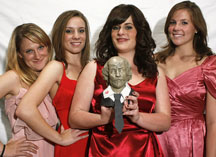Nov. 3, 2011
ISU, national coalition build next generation of science faculty
by Diana Pounds
Call it the trickle-down theory of science and technology education. Help Ph.D.s and post-docs (future professors) become great teachers, and they, in turn, inspire students to succeed in science, technology, engineering and math (STEM) fields. The inspired students go on to become the next generation of scientists and engineers, helping to ease a projected shortage of such workers in the United States.
A national coalition of universities, including Iowa State, is on a mission to do just that by helping science graduate students become as skilled in classrooms as they are in labs. The Center for the Integration of Research, Teaching and Learning (CIRTL), began in 2003 with a handful of universities* and recently expanded to 25 of the nation's top schools.
A good fit
Holly Bender, a professor in veterinary pathology who directs the Preparing Future Faculty program in the Center for Excellence in Learning and Teaching, led the team that submitted ISU's proposal for CIRTL membership. She attributed the success of that proposal to strong activities already under way at ISU, such as programs on Preparing Future Faculty, Strengthening the Professoriate and scholarship of teaching and learning; nationally touted learning communities; and multiple campus initiatives focused on increasing diversity.
"We will take existing ISU programs and strengthen them by finding common visions and networking people together, both locally and with the other 24 institutions of the CIRTL network," Bender said.
The United States faces a shortage of workers with bachelor's degrees in science and technology fields, Bender said.
Keeping students on the science track
"Currently, more than 60 percent of students who initially go into STEM fields in college become discouraged and change majors," she said. "If we can keep a quarter of these students engaged, that will help meet growing demand for workers with science backgrounds."
The CIRTL schools, and the National Science Foundation (NSF), which is supporting them, believe excellent teachers will keep students engaged and on the science track.
"Currently, more than 60 percent of students who initially go into STEM fields in college become discouraged and change majors."
Holly Bender
The universities will beef up doctoral students and post-docs' classroom skills by offering a smorgasbord of courses, seminars, learning communities and training exchanges. CIRTL also calls for diversity training for future professors.
"Problem solving is enhanced when people with diverse backgrounds are brought into the conversation," Bender said. "We need to find better ways to encourage women to go into fields like math and engineering and to encourage under-represented minorities to stay in STEM fields. By doing so, we advance these fields."
Bender and Craig Ogilvie, assistant dean of the graduate school, will co-direct ISU's CIRTL initiative.
"We're contacting leaders throughout the university to help us form a collective vision and coordinate efforts," Bender said.
How to get involved
Bender encouraged anyone who wants to be a part of CIRTL activities to contact the Center for Excellence in Learning and Teaching at celt@iastate.edu.
"This is transformative," she said. "I really think this network is going to change the direction of higher education. It's going to make our teaching much more effective, not only for our graduates, but our undergraduates."
*The original six CIRTL universities were: Howard University, Michigan State, Texas A&M, University of Colorado, University of Wisconsin (where CIRTL is headquartered) and Vanderbilt University.
